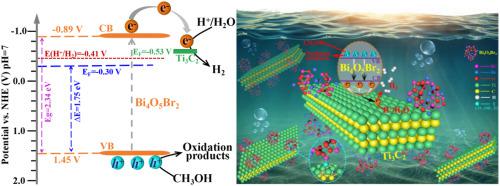Journal of Solid State Chemistry ( IF 3.2 ) Pub Date : 2020-05-24 , DOI: 10.1016/j.jssc.2020.121470 Qing Xi , Xiuping Yue , Junqiang Feng , Jianxin Liu , Xiaochao Zhang , Changming Zhang , Yawen Wang , Yunfang Wang , Zhiping Lv , Rui Li , Caimei Fan

|
Photocatalytic hydrogen evolution via water splitting was considered as a promising way of solar energy conversion and storage in the past decades. However, the weak visible-light response and fast recombination of electron-hole pairs are still main obstacles to overcome. Herein, a novel 2D/2D Bi4O5Br2/TL-Ti3C2 (Thin layer-Ti3C2) visible-light photocatalyst was successfully prepared by in-situ synthesis of Bi4O5Br2 nanosheets on the surface of TL-Ti3C2 at room temperature. The resulting Bi4O5Br2/TL-Ti3C2 exhibits a higher hydrogen evolution activity (83.5 μmol·g−1·h−1) than that of pristine Bi4O5Br2 (44.9 μmol·g−1·h−1) under visible-light irradiation. The enhanced hydrogen evolution activity of as-prepared photocatalyst mainly attributes to the increased visible light responsiveness and rapid transfer of photo-induced electrons. The strong interaction between TL-Ti3C2 and Bi3+ in Bi4O5Br2 nanosheets establishes a good electron transfer channel and close contact, which accelerates the transfer of photo-induced electrons from Bi4O5Br2 to Ti3C2 and promotes the separation of photo-generated charge carriers, thereby increasing the number of effective photo-induced electrons involved in the hydrogen evolution. This work provides a new insight into the construction of BixOyBrz/MXene photocatalyst system, and demonstrated that Ti3C2 has excellent application potential in promoting the photocatalytic performance of bismuth-rich bismuth oxyhalides (BixOyXz X = Cl, Br, I).
中文翻译:

简便合成2D Bi 4 O 5 Br 2 / 2D薄层-Ti 3 C 2,以改善可见光光催化氢的释放
在过去的几十年中,通过水分解产生的光催化氢被认为是太阳能转化和存储的一种有前途的方式。然而,弱的可见光响应和电子-空穴对的快速重组仍然是要克服的主要障碍。本文通过在表面上原位合成Bi 4 O 5 Br 2纳米片,成功制备了新型2D / 2D Bi 4 O 5 Br 2 / TL-Ti 3 C 2(薄层-Ti 3 C 2)可见光催化剂。室温下TL-Ti 3 C 2的表面。生成的Bi 4 O5溴2 / TL-的Ti 3 c ^ 2表现出更高的析氢酶活性(83.5微摩尔·克-1 ·H -1)比原始的Bi 4 ø 5溴2(44.9微摩尔·克-1 ·H - 1)在可见光照射下。所制备的光催化剂增强的氢释放活性主要归因于可见光响应性的提高和光诱导电子的快速转移。TL-Ti 3 C 2与Bi 3+在Bi 4 O 5 Br 2中的强相互作用纳米片建立了良好的电子传输通道并紧密接触,从而加速了光致电子从Bi 4 O 5 Br 2到Ti 3 C 2的转移,并促进了光生载流子的分离,从而增加了有效光子的数量。 -诱导的电子参与氢的释放。这项工作为Bi x O y Br z / MXene光催化剂体系的构建提供了新的见解,并证明了Ti 3 C 2在促进富铋氧化物卤化铋(Bi xO y X z X = Cl,Br,I)。









































 京公网安备 11010802027423号
京公网安备 11010802027423号